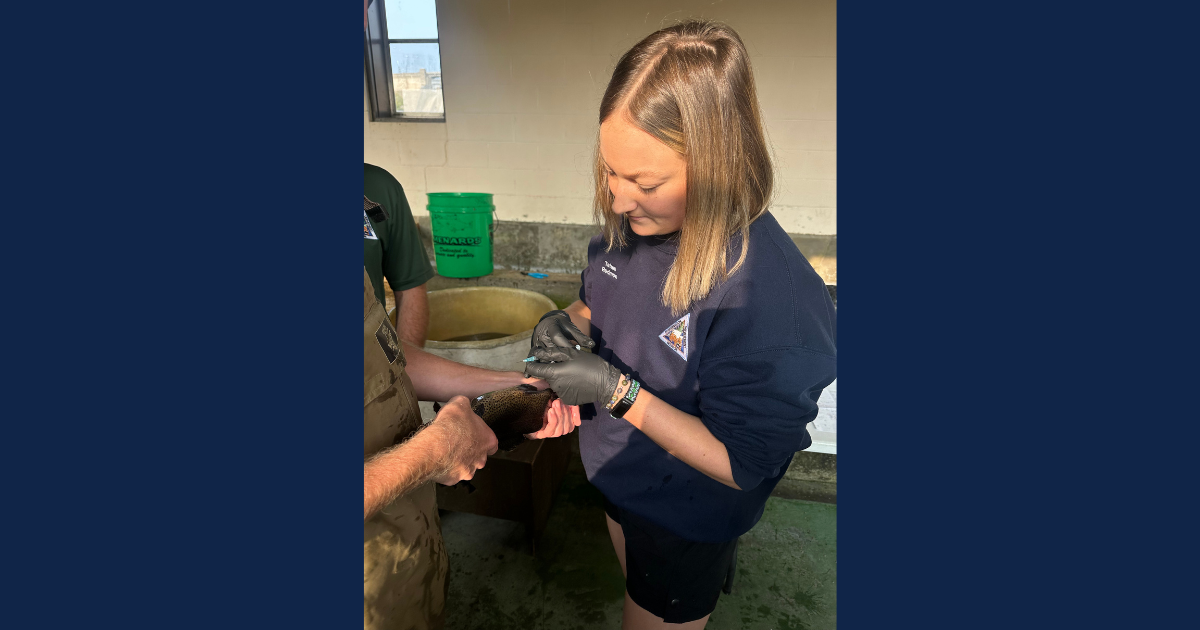New Collaboration Brings Conservation Employee to Lincoln Graduate Program
Office of Communications and Marketing
Young Hall
820 Chestnut Street
Jefferson City, MO 65101
 MDC Aquatic Animal Health Scientist and LU graduate student Tatum Redmon injects a rainbow trout with thiamine hydrochloride at Shepherd of the Hills State Fish Hatchery in Branson, Missouri.
MDC Aquatic Animal Health Scientist and LU graduate student Tatum Redmon injects a rainbow trout with thiamine hydrochloride at Shepherd of the Hills State Fish Hatchery in Branson, Missouri.
For possibly the first time, the Missouri Department of Conservation (MDC) is paying for one of its employees to earn a graduate degree at Lincoln University’s (LU) College of Agriculture, Environmental and Human Sciences (CAEHS).
Through this collaboration, Tatum Redmon, an MDC aquatic animal health scientist, is earning her master’s degree in sustainable agriculture (with an emphasis on aquaculture) at Lincoln.
Lincoln faculty and staff hope this fledgling partnership could begin a lasting and impactful relationship between the university and state agency.
“It’s a good partnership," said LU Aquaculture Manager Jacob Loesch. "They can do the research there and get the education here. Then they can take that back and share experiences."
He added that he has never seen a collaboration quite like this between MDC and the university.
Loesch initiated the collaboration almost by chance. While attending a Missouri Aquaculture Association event, Loesch ran into Sherri Russell, MDC state wildlife veterinarian. As they spoke, Russell revealed she wasn’t aware Lincoln even had an agriculture graduate program and remarked MDC typically sent employees to the University of Missouri.
“She said, ‘Do you care if we send someone to your program?’ and I said absolutely not,” Loesch recalled. “I think it’s a really good partnership to make. With MDC headquarters and Lincoln being in the same town, it’s really beneficial."
Redmon has a bachelor’s degree and began her job at MDC with the understanding they would pay for her to get her master’s. Starting last fall — and supported by MDC funding — Redmon began her work in CAEHS’ graduate program.
She’s conducting her research under the guidance of Dr. Moureen Matuha, an assistant professor of aquaculture at Lincoln, and Russell at MDC.
Redmon’s research explores the effects of thiamine supplementation on early life stages of hatchery-reared rainbow trout in Missouri.
Matuha explained that rainbow trout in Missouri’s state hatcheries experience high mortality rates during early life stages. Existing literature suggests thiamine deficiency during this period may be the culprit, so Redmon sought to conduct a study and find a definitive answer.
Her study involves injecting rainbow trout ‘broodstock’ with thiamine prior to spawning and immersing eggs in thiamine baths, then monitoring eggs and hatchlings as they progress through early life stages, searching for improvements to survival rates, hatching rates, growth and more.
Matuha said a similar study in Oregon on steelhead trout produced positive results.
If Redmon’s study is successful and reveals a correlation between thiamine supplementation and healthier early life stages for rainbow trout, Matuha said the research could be implemented as a model for thiamine supplementation at MDC hatcheries and possibly applied to other trout strains.
Redmon initially conducted her study during the fall, Matuha said, but complications required Redmon to repeat the study. Now, her research is back in full swing at MDC’s Shepherd of the Hills State Fish Hatchery in Branson.
“Right now, she’s taking classes, and at the same time, she has to focus on her job, and she has to do her research,” Matuha said. “It’s quite busy for her, but it’s good. Sometimes as a graduate student, that’s what you have to do.”
Matuha remarked Lincoln hasn’t collaborated much with MDC in the past. However, between funding Tatum’s education and providing fish for aquaculture research, that appears to be changing.
“We’ve met with them at conferences," Matuha said. "They’re really, really supportive. I love the way they’re willing to work with us."
